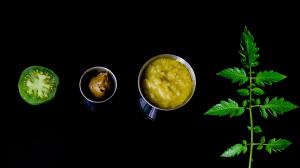Did you say tomato leaves ? YES ! Green tomatoes ? Why not ! Of course there are many other tomatoes that are more appropriate for purée, sauce & paste, but I couldn’t resist the vibrant green colour. The taste of the green tomatoes, whether as a purée, sauce or paste is quite different from red tomatoes, it’s fruitier with notes of pineapple and kiwi when it cooks longer and caramelizes ! Anyone who grows tomatoes knows that you have to pinch off those tomato plant branches with too many leaves and no blossoms on them, in order to allow the sap to go more directly to the actual tomato fruits and become bigger, juicier, tastier tomatoes ! The tomato leaves are extremely fragrant and I always regretted throwing them away, after crushing them in my hands and enjoying the fragrance ! Following some time spent researching the so-called toxicity of tomato leaves, I was happy and reassured to find out that not only were they not toxic but actually good for your cholesterol levels ! Anyways, this was somewhat experimental and educational … Understanding the difference between what you start off with (in weight) and what you end up with, after different stages of cooking (and baking) and also the differences in flavours between a slightly cooked purée which is fresh and fruity, a sauce, with more developed and warmer flavours and of course finally, the tomato paste which needs to be reduced in the oven at low heat and caramelizes to become something quite intense and sweet and powerful ! The aim here is to talk about preparing and combining these 3 distinct flavours, in different ways and ratios, to create the perfect sauce for warm or cold pasta, pizza, etc … Surprise, surprise concerning what you start off with and what you end up with. Here’s a quick lesson : 1kg of fresh tomatoes will give you about 750 grams of purée (75% of the original total) or 500 grams of sauce (50% of that 1kg) and only 50 grams in paste (5% of the original 1kg) …This is why this recipe requires 3kg of tomatoes, in order to make 250 grams of slightly-cooked purée, 500 grams of sauce and 50 grams of amazing tomato paste. Then you can recombine the 3 elements to create your own flavour combinations and levels of intensity ! So, are you going to give it a try ?! We’ll see... :)












